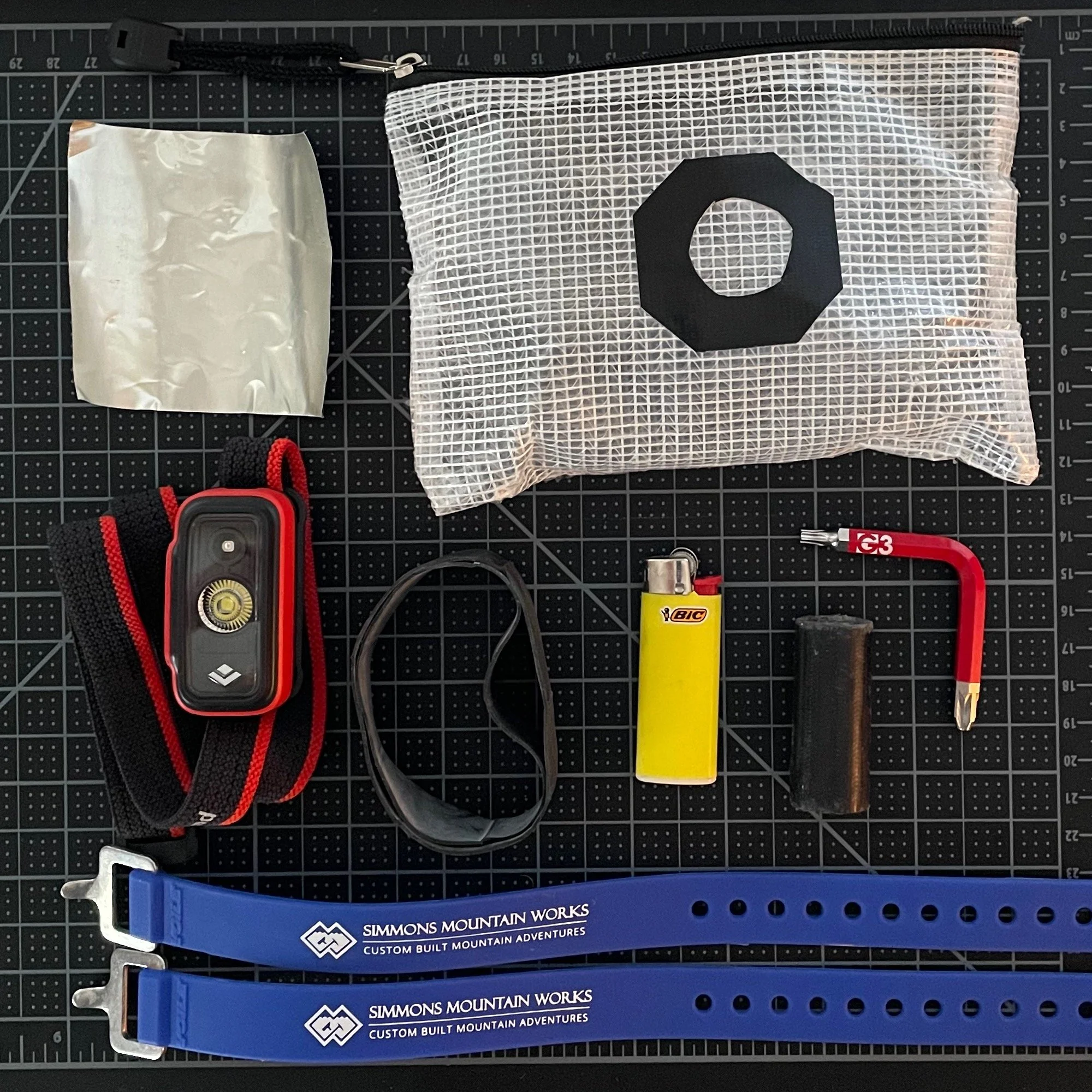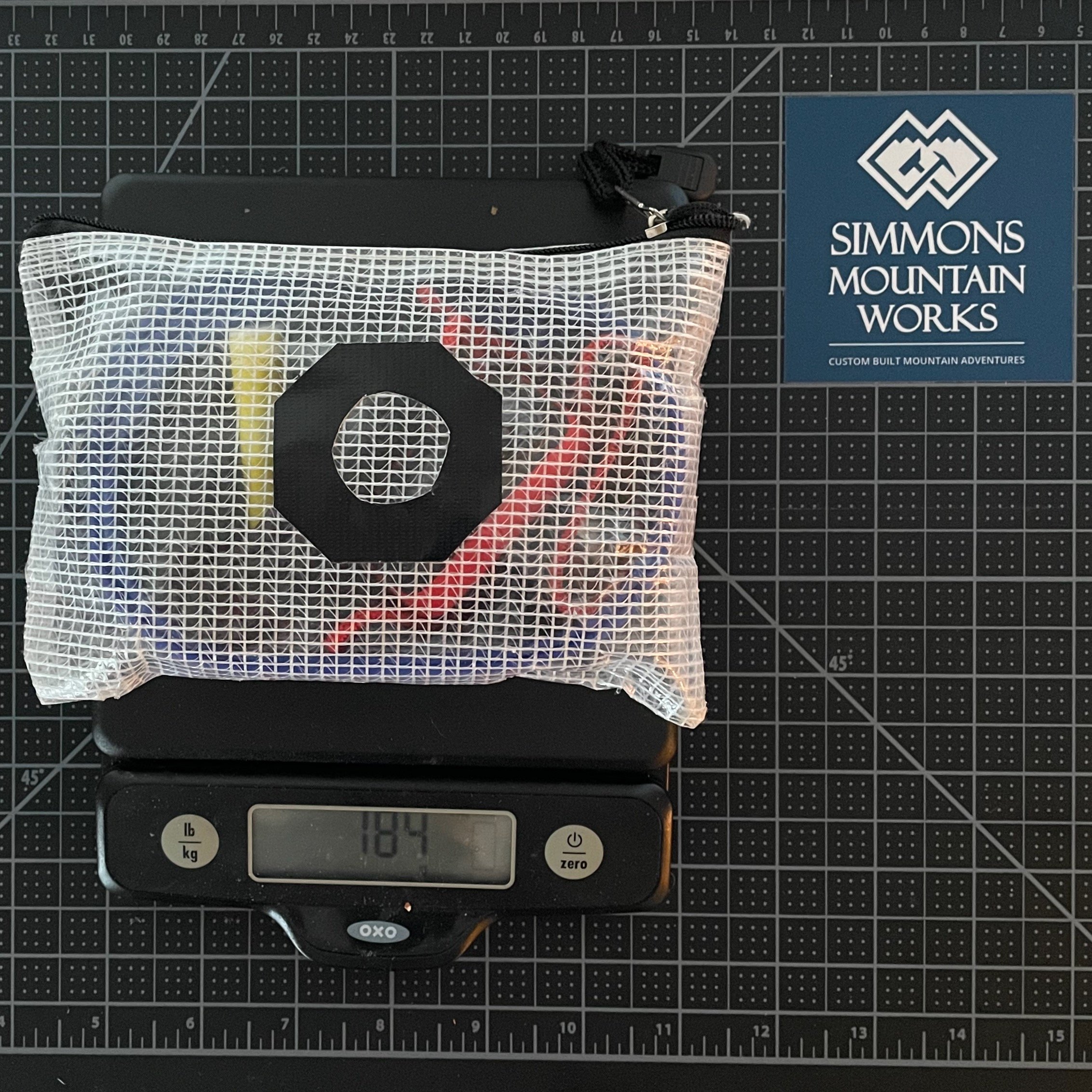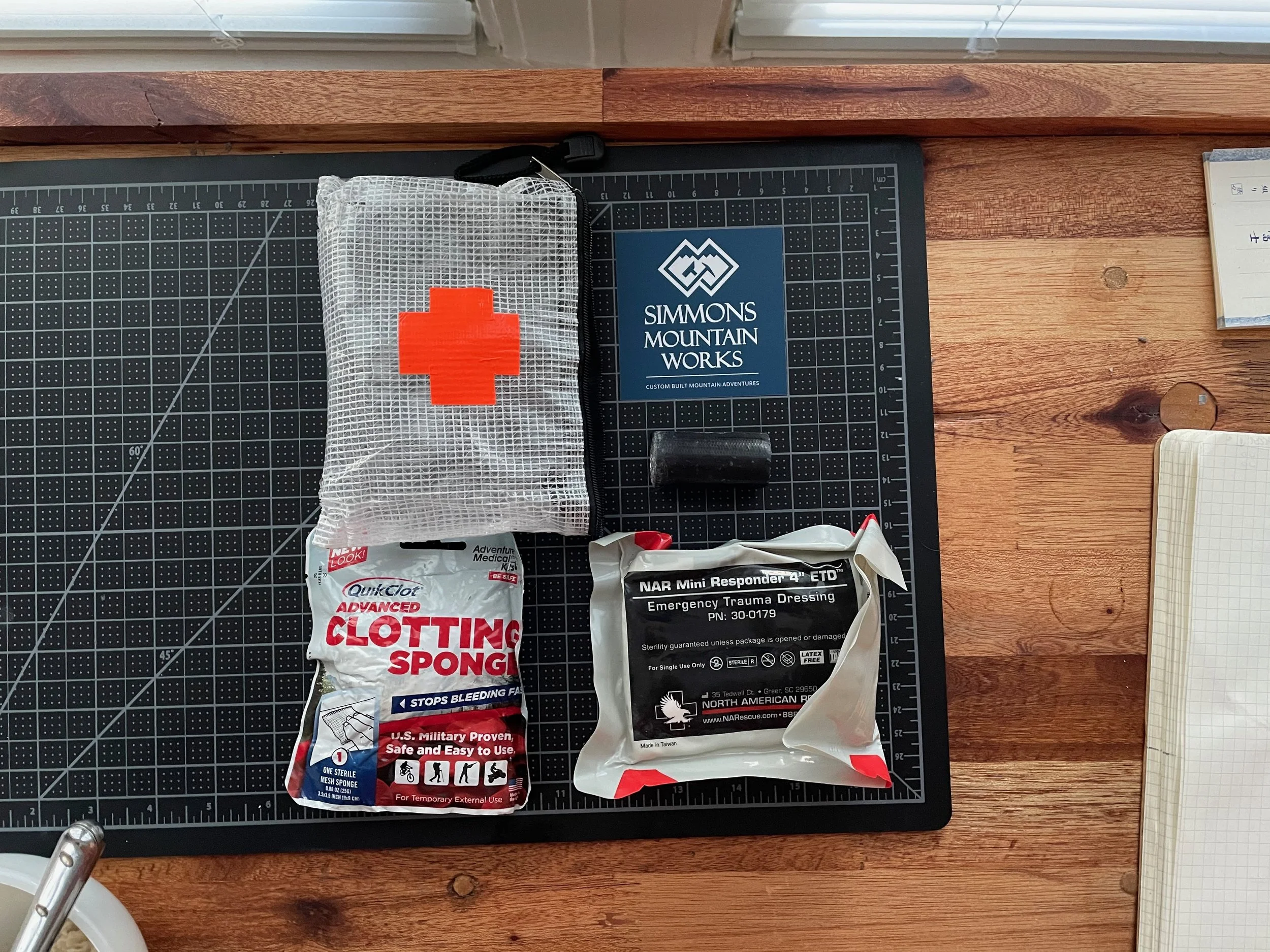The SHTF Kit - step 1
My personal first aid and repair kits aren’t for boo-boos. I carry them for when !@#$ seriously goes wrong, and what I want to do is stabilize and go home. My kits have two seasons - winter (skiing) and summer (alpine). They have two very different standards - personal and professional. And they have three stages: day missions-front country; day missions-remote; and overnight missions.
Overnight considerations: I’m already bringing shelter (my tent), so I’ll only bring an emergency shelter if I’m leaving a camp and going on a tour or climb with a difficult return. Possible examples: the North Ridge of Baker with a base camp at the Hogsback, summit day on Mt Olympus. My first aid kit is beefed out with more material to change bandages in case I need to wait for aid to come to me. I’ll write more about this in April and May.
Remote considerations: I define remote as anywhere I travel to from which getting to a road access is not directly downhill. Overnight missions are automatically remote. Possible examples: the Chair Peak circumnavigation ski tour. I start considering carrying shelter on remote missions.
But this is the beginning - day missions with direct exits. This is what I carry:
Headlamp, so I’m not as afraid of finishing in the dark.
Small lighter
2 x “ranger bands” these are cut from bicycle inner tubes. In addition to being great big rubber bands, once lit these burn for an impressive amount of time and with a lot of heat. Awesome firestarters.
1.5 meters / 5 feet of duct tape. My favorite brand in the US is Gorilla. Patches holes in fabric, helps secure bandages and splints. And my preferred blister patch on meself.
G3 Backcountry Binding Tool. With a Pozi #3 on one end and a Torx T20, this tool covers more than +80% of the screw heads used in the industry.
5-7cm / 2-3 inch square of aluminum, cut from a Red Bull can. This is the magic for splinting a broken ski pole and weighs nothing. Wrap it around at the fracture and then use that roll of tape to secure it. Two hose clamps would do a better job, but then I’d need a multi tool with a Philips head driver.
3 x Voile ski straps, 20 inch / 48cm. Works from 5.5” - 18” / 14cm - 46cm. I’ve seen plastic buckles break in the field, so i prefer classic metal. 20 inches is the goldilocks size. I keep one out to package up my skis and two more in my kit. Good for splinting ski boots, splinting boots to bindings, and splinting people. Message if you’d like to get a set of branded straps from me.
Quick-clot bandage for big bleeds. Pretty self explanatory. If someone is pumping out blood I’d slap this on and then stack on top the…
NAR Mini Responder 4” ETD. The North American Rescue’s Emergency Trauma Dressing is a bandage with a compression strap built in. After this was secure I’d consider adding…
1.5 meters / 5 feet of duct tape. Yeah a second role. Believe me, if someone is this traumatized I’m going to wrap them up like a &=%&ing mummy. Also useful for boo-boos.
iPhone 13 mini cell phone. In my left pocket.
Opinel #6 pocket knife. In my right pocket. Gotta be able to cut stuff up.
Satellite messaging device. I have been rocking a Garmin inReach Mini Gen 1, but this year I’ll be upgrading to a Gen 2, Messenger or a Zoleus, still TBD.
Two bags to keep them in. I’m ordering an assortment of DAKA pouches from Magpul - TPU plastic; multiple colors and sizes; lightweight, “standard”, and waterproof zipper options.
Discussion:
I feel like I’m opening meself up to a lot of criticism here. So I want to emphasize that this is my PERSONAL kit, not guiding. And it’s based on all the people and equipment failures I’ve seen over 30 years of backcountry skiing 50-100 days a year, personally and professionally.
This is the kit I wish everyone carried everyday, at a minimum. Imagine going for a ski tour with two good friends. If each of us was carrying this kit we’d have more than enough material to improvise If someone blew a knee, broke an ankle or arm, snapped a pole, broke a buckle, or blew a heal piece. Bigger repair and first aid kits can be added to supplement this kit as needed for longer and more remote tours.
“What about repairing a binding?” I’m sure someone will ask. What I like to carry is enough to cancel the rest of my tour and limp out, not to replace and continue on. My regular partners and I agree that we prefer to maintain our equipment, replace it at reasonable intervals and not wait for something to fail first. That reduces the likelihood of something like a binding heal piece “spontaneously” failing after a decade of use. Instead I try to replace my complicated things - bindings, boots, and beacons - every four years.
I consider bringing a tarp to improvise a shelter or a rescue sled when my exit or retreat requires a climb over a ridge or through a pass. If it’s a straight shot to a road (not even the road we started from) then I’m often willing to forego these pieces.
That’s my two bits. Later in February I’ll show off my guiding day kits and in April my overnight tour kits. Let me know what you think and if you have any pieces of kit I should look at!Headlamp, so I’m not as afraid of finishing in the dark.
Small lighter
2 x “ranger bands” these are cut from bicycle inner tubes. In addition to being great big rubber bands, once lit these burn for an impressive amount of time and with a lot of heat. Awesome firestarters.
1.5 meters / 5 feet of duct tape. My favorite brand in the US is Gorilla. Patches holes in fabric, helps secure bandages and splints. And my preferred blister patch on meself.
G3 Backcountry Binding Tool. With a Pozi #3 on one end and a Torx T20, this tool covers more than +80% of the screw heads used in the industry.
5-7cm / 2-3 inch square of aluminum, cut from a Red Bull can. This is the magic for splinting a broken ski pole and weighs nothing. Wrap it around at the fracture and then use that roll of tape to secure it. Two hose clamps would do a better job, but then I’d need a multi tool with a Philips head driver.
3 x Voile ski straps, 20 inch / 48cm. Works from 5.5” - 18” / 14cm - 46cm. I’ve seen plastic buckles break in the field, so i prefer classic metal. 20 inches is the goldilocks size. I keep one out to package up my skis and two more in my kit. Good for splinting ski boots, splinting boots to bindings, and splinting people. Message if you’d like to get a set of branded straps from me.
Quick-clot bandage for big bleeds. Pretty self explanatory. If someone is pumping out blood I’d slap this on and then stack on top the…
NAR Mini Responder 4” ETD. The North American Rescue’s Emergency Trauma Dressing is a bandage with a compression strap built in. After this was secure I’d consider adding…
1.5 meters / 5 feet of duct tape. Yeah a second role. Believe me, if someone is this traumatized I’m going to wrap them up like a &=%&ing mummy. Also useful for boo-boos.
iPhone 13 mini cell phone. In my left pocket.
Opinel #6 pocket knife. In my right pocket. Gotta be able to cut stuff up.
Satellite messaging device. I have been rocking a Garmin inReach Mini Gen 1, but this year I’ll be upgrading to a Gen 2, Messenger or a Zoleus, still TBD.
Two bags to keep them in. I’m ordering an assortment of DAKA pouches from Magpul - TPU plastic; multiple colors and sizes; lightweight, “standard”, and waterproof zipper options.
Discussion:
I feel like I’m opening meself up to a lot of criticism here. So I want to emphasize that this is my PERSONAL kit, not guiding. And it’s based on all the people and equipment failures I’ve seen over 30 years of backcountry skiing 50-100 days a year, personally and professionally.
This is the kit I wish everyone carried everyday, at a minimum. Imagine going for a ski tour with two good friends. If each of us was carrying this kit we’d have more than enough material to improvise If someone blew a knee, broke an ankle or arm, snapped a pole, broke a buckle, or blew a heal piece. Bigger repair and first aid kits can be added to supplement this kit as needed for longer and more remote tours.
“What about repairing a binding?” I’m sure someone will ask. What I like to carry is enough to cancel the rest of my tour and limp out, not to replace and continue on. My regular partners and I agree that we prefer to maintain our equipment, replace it at reasonable intervals and not wait for something to fail first. That reduces the likelihood of something like a binding heal piece “spontaneously” failing after a decade of use. Instead I try to replace my complicated things - bindings, boots, and beacons - every four years.
I consider bringing a tarp to improvise a shelter or a rescue sled when my exit or retreat requires a climb over a ridge or through a pass. If it’s a straight shot to a road (not even the road we started from) then I’m often willing to forego these pieces.
That’s my two bits. Later in February I’ll show off my guiding day kits and in April my overnight tour kits. Let me know what you think and if you have any pieces of kit I should look at!
A minimalist repair kit.
The whole repair kit only weights 184gm - less than a candy bar.
This is really all I need for first aid - everything else I can improvise!



